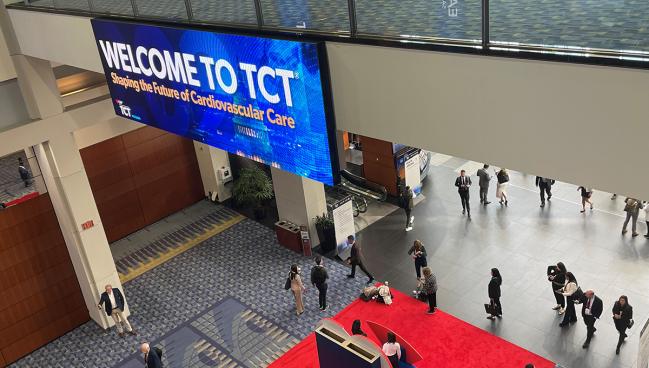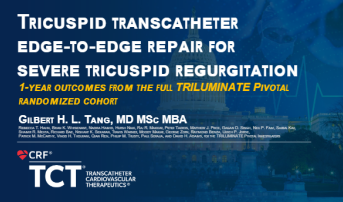TRILUMINATE: More Patient Data Reassure on TEER’s Benefits for Severe TR
New analyses bolster the case for tricuspid TEER and reassure on outcomes in patients with implanted electronic devices.

WASHINGTON, DC—Newly reported data from the TRILUMINATE randomized trial provide more objective evidence in support of transcatheter edge-to-edge repair (TEER) in patients with symptomatic severe tricuspid regurgitation (TR).
The complete TRILUMINATE results, which were presented this week at TCT 2024, and published simultaneously in JACC, include additional patients and hint at a reduction in heart failure (HF) hospitalizations, as well as a significant improvement in the 6-minute walk distance (6MWD) that wasn’t seen in the primary analysis.
Gilbert Tang, MD (Icahn School of Medicine at Mount Sinai, New York), who presented the results, said the findings help rebut some of the initial criticisms of TRILUMINATE, particularly that the benefit of TEER was driven by softer endpoints, such as changes in patient symptoms and quality of life as assessed by the Kansas City Cardiomyopathy Questionnaire (KCCQ).
“People said: it’s subjective, or there’s a placebo effect [because] you don’t have a sham control,” Tang told TCTMD. “But at least with the 6-minute walk test, it’s an objective measure of functional capacity and functional status. We think that’s encouraging.”
Colin Barker, MD (Vanderbilt University Medical Center, Nashville, TN), the scheduled discussant following the presentation, said he wished these data were available earlier.
“It would have been a lot easier sell to regulatory pathways and referring patients,” he said. “I think it’ll now add some justification and validation of this therapy. It reinforces again that less TR is better and that should still be a goal for all of us when we're treating these patients: minimize the TR as much as possible.”
Barker said that he’s always been skeptical of the KCCQ in the setting of tricuspid valve disease because it was initially designed for assessing heart failure patients.
“Some of them have heart failure, but a lot of them have non-heart failure factors that affect their quality of life,” said Barker. “They feel miserable. They're not hungry. They can't sleep. I think ultimately as we learn more about these patients, designing something that would be more specific for the tricuspid population for assessing their quality of life would be meaningful and helpful.”
In addition to the full TRILUMINATE data, investigators also presented data on outcomes in patients with and without cardiac implantable electronic device (CIED) leads, reporting that they observed no difference in outcomes in those with and out the pacemaker and implantable cardioverter-defibrillators (ICD) leads.
More Patients, Shifting Results
The TRILUMINATE trial results were presented in 2023 at the American College of Cardiology Scientific Sessions and subsequently published in the New England Journal of Medicine. On the basis of the study, the US Food and Drug Administration approved TEER with TriClip for patients with symptomatic severe TR who are not candidates for surgery.
The study investigators used an adaptive trial design to assess safety and effectiveness and reestimated the sample size as the trial progressed. The FDA approval was based on the results of 350 patients, a sample size that was sufficient to assess the primary endpoint, but the researchers continued to randomize until 572 patients were included in the study.
Among the fully randomized cohort, the primary composite outcome consisting of all-cause death or tricuspid valve surgery; HF hospitalization; and improvement in quality of life according to the KCCQ still favored TEER over medical therapy alone (win ratio 1.84; 95% CI 1.40-2.45). Like the primary analysis, there was no improvement in freedom from mortality/tricuspid valve surgery or heart failure hospitalizations, with the benefit driven by an improvement in the KCCQ.
In the initial 350-patient analysis, there was no significant improvement in the 6MWD with TEER, but that changed in favor of device therapy with the additional patients (19.6 m with TEER vs -12.2 m with control; P = 0.01). The improvement in 6MWD was strongly linked with the reduction in TR grade from baseline.
“Even the control group has some patients who had an improvement in TR,” said Tang. “When the TR improved, their functional status also improved. That means it's not really a placebo effect because otherwise you wouldn't have seen that. It’s encouraging to us that this is a biological effect—the more you can improve TR, the more improvement you’re going to get.”
With respect to HF hospitalizations, there also appeared to be a benefit with TEER. When investigators focused solely on the additional 222 patients who made up subsequent enrollment, treatment with TriClip reduced the risk of HF hospitalizations (annualized rate 0.09 with TEER vs 0.20 in the control arm; P = 0.04).
Tang said there aren’t any identifiable differences between the initial 350 patients—in whom there was no reduction in HF hospitalizations with TEER—and the subsequent 222 patients to explain why they saw a differences in outcomes.
“I want to be cautious here,” he said. “It’s not like, wow, we suddenly see a big difference [in heart failure hospitalizations], but keep in mind that this trial was conducted during the COVID-19 pandemic. Whether that has any impact, we don’t know. . . . I think we need to look at the longer-term impact of this observation and whether [the benefit] is real or not.”
What About Patients With CIED Leads?
Hursh Naik, MD (St. Joseph’s Hospital and Medical Center, Phoenix, AZ), who presented the lead data, said that patients with severe TR frequently have leads for pacemakers or ICDs, and it’s frequently debated whether TEER is a safe and effective option for them.
In the new analysis, which focused on the 285 patients treated with the device in the randomized trial plus 200 patients treated with TriClip in a separate single-arm study, there 98 patients with a transvalvular CIED lead and 371 patients without one. Baseline characteristics between those with and without leads were similar, although those with a lead were more likely to have torrential TR.
At 12 months, there was a similar improvement in TR severity with TEER, as well as significant and sustained improvements in HF symptoms, in those with and without CIED leads. Improvements in quality of life assessed by KCCQ were also similar in those with and without leads. There was no difference in all-cause mortality or HF hospitalizations between the two patient groups.
Naik noted that fewer clips were used in those with CIED leads. Also, the patients with leads were more likely to be treated with the TriClip G4 system, as opposed to an earlier-generation device, which might be beneficial because the G4 has the ability to independently grasp tricuspid leaflets.
“In fact, there was one patient taken off the table because they waited for the G4 to come in so they could treat that patient successfully,” said Naik.
Procedural outcomes were excellent, said Naik, noting there were no difference in procedure or device times with the presence of a lead. Adverse events at 1 year were very low, with no pericardial effusion), and no need for lead revisions, replacements, or removal.
“Nothing with the lead affected the patient,” said Naik.
Who Not to Treat With Leads?
Scott Chadderdon, MD (Oregon Health & Science University, Portland), one of the panelists during the TCT session, said how to deal with symptomatic severe TR patients with a CIED lead is a hot topic amongst operators. “We are seeing a lot of patients with a lead, and I think as a community we're still trying to figure out if these patients are best treated by the commercial approaches that we have right now,” he said.
Sidakpal Panaich, MD (Swedish Heart & Vascular Institute, Seattle, WA), also a panelist, pointed out that not all patients with CIED leads were enrolled in the trials, which opens up a knowledge gap.
“Do we have information on which patients with leads were not enrolled versus these patients?” he asked. “We can do patients with leads, but who are the patients we can’t?”
Recently, electrophysiologists have pushed for greater involvement in heart team discussions for patients undergoing structural procedures. Lead management in those undergoing percutaneous tricuspid valve replacement or repair is important, they say, particularly given the risks. With transcatheter tricuspid valve replacement (TTVR), for example, there is a risk of jailing preexisting leads where they are pushed up against the heart tissue or an older valve by the new transcatheter device.
To TCTMD, Tang said the lead analysis is reassuring. “With certain anatomies, you can get a good reduction in TR and good functional improvement [with TEER],” he said. While TTVR does carry risks of jailed leads and resulting heart block, the upside is that it eliminates TR, he said.
Michael O’Riordan is the Managing Editor for TCTMD. He completed his undergraduate degrees at Queen’s University in Kingston, ON, and…
Read Full BioSources
Tang GHL, Hahn RT, Whisenant BK, et al. Tricuspid transcatheter edge-to-edge repair for severe tricuspid regurgitation. Presented at: TCT 2024. October 27, 2024. Washington, DC.
Naik H, Price M, Kapadia S, et al. Tricuspid transcatheter edge-to-edge repair in patients with transvalvular CIED leads. Presented at: TCT 2024. October 27, 2024. Washington, DC.
Disclosures
- Tang reports speaking honoraria from Medtronic, Abbott, and Siemens Healthineers; consulting for Medtronic, Abbott, Shockwave Medical, NeoChord, Peija Medical, and Shenqi Medical Technology; and serving on an advisory board for Medtronic, Abbott, Boston Scientific, and JenaVave.
- Naik reports consulting fees from Abbott, Boston Scientific, and Edwards Lifesciences.






Comments